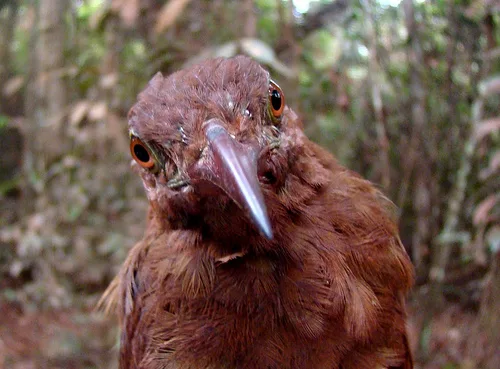
Brigidas Woodcreeper
[order] PASSERIFORMES | [family] Furnariidae | [latin] Hylexetastes brigidai | [UK] Brigidas Woodcreeper | [FR] Grimpar de Brigidai | [DE] Rotschnabel-Baumsteiger | [ES] Trepatroncos Piquirrojo | [NL]
Subspecies
Monotypic species
Physical charateristics
A large Woodcreeper with a heavy red slightly curved bill. Crown and mantle dark olive-brown, lores and stripe below the eyes white. Rump and upper tail coverts chestnut, wings and tails rufous chestnut. Sides of the throat olive-brown, center of throat whitish. Lower underparts light olive brown, center of belly lighty barred blackish. legs olive green. Sexes are alike.
| wingspan min.: | 0 | cm | wingspan max.: | 0 | cm |
| size min.: | 25 | cm | size max.: | 30 | cm |
| incubation min.: | 15 | days | incubation max.: | 21 | days |
| fledging min.: | 19 | days | fledging max.: | 23 | days |
| broods: | 1 | eggs min.: | 2 | ||
| eggs max.: | 3 |
Range
South America : Northcentral Brazil
Habitat
Humid terra firme lowland forest and hilly forest in the Guianan interior. Sometimes gallery forest or flooded forest.
Reproduction
Little known. Nest is in a cavity or old nest ner the top of an old tree stump. likely to have only one egg. After fledging the young is dominant over the male parent, but not the female. Rareness of species suggests low breeding success rate.
Feeding habits
It lives alone or in pairs, also joining mixed-species flocks, and is very difficult to spot. As the dominant (largest) species among the various birds that follow army ants, it obtains the best feeding places. Diet consists of anthropods like ants and wasps, sometimes small vertebrates are taken. Sallies for prey to ground or gleans insects from bark. Moslty found near or over ant armies.
Conservation
This species has a very large range, and hence does not approach the thresholds for Vulnerable under the range size criterion (Extent of Occurrence <20,000 km2 combined with a declining or fluctuating range size, habitat extent/quality, or population size and a small number of locations or severe fragmentation). The population trend appears to be stable, and hence the species does not approach the thresholds for Vulnerable under the population trend criterion (>30% decline over ten years or three generations). The population size has not been quantified, but it is not believed to approach the thresholds for Vulnerable under the population size criterion (<10,000 mature individuals with a continuing decline estimated to be >10% in ten years or three generations, or with a specified population structure). For these reasons the species is evaluated as Least Concern.
Found in Bolivia, Brazil, French Guiana, Guyana, Suriname, and Venezuela.
Found in Bolivia, Brazil, French Guiana, Guyana, Suriname, and Venezuela.

Migration
Sedentary throughout range.
Distribution map

